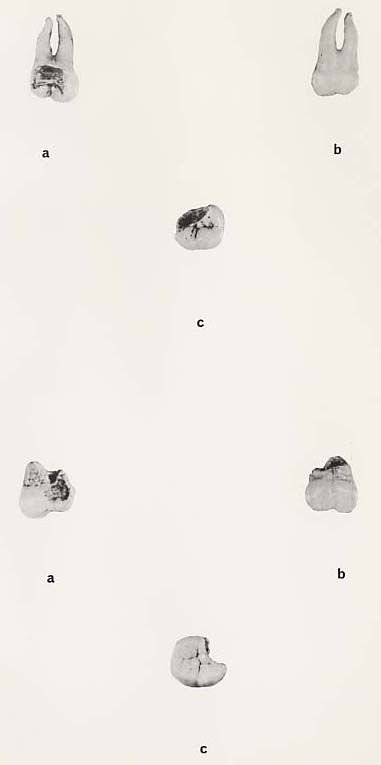APPENDIX I ISOLATED HUMAN TEETH FROM KAMITAKATSU SHELL-MIDDEN SITE
Y. FUKUSHIMA
|
Two isolated human teeth are found in Layers C and D. Both are lower third molars. These teeth apparently belong to adults but of unknown sex. The condition of preservation is fairly good. Lower Right Third Molar from Layer C (Plate XXVIII:1)It has two roots and may have four cusps, though one-third of the tooth is decayed away (Plate XXVIII: 1-a, c). From the shape of the crown and roots this tooth appears to be a lower right third molar. The crown height of the mesiobuccal cusp (Protoconid) is 4.6 mm, the height of the mesial root is 13.2 mm and the total height is 18.0 mm. Compared with the average modern Japanese, the crown height is smaller but the root and total height are greater (Table 18). Attrition is still in the first degree in Broca's classification. It is found on the tops of the mesiolingual (metaconid) and buccal cusps (proto- and hypoconid) and on the upper part of the buccal surface. The degree of caries on the distolingual cusp (entoconid) is advanced to the third stage. The cusp is completely decayed far into the neck and the pulp cavity is partly exposed.
Lower Left Third Molar from Layer D (Plate XXVIII:2)It has an X-pattern occlusal groove with four cusps. The root has two branches which are broken almost completely. The furrow on the buccal side continues to an enamel line on the root. The surface has a complex appearance. The crown height of the mesiobuccal cusp (protoconid) is 10.8 mm and the mesiodistal diameter of the crown is 10.4 mm. The crown height is much greater than the mean of modern Japanese but the mesiodistal diameter of the crown is less. Slight attrition is found on the two distal cusps (hypoconid and the remaining part of entoconid), but there is no distinct attrition on the two mesial cusps (proto- and metaconid). Therefore, it can be supposed that the axis of this tooth was inclined foreward. Most of the distolingual cusp (entoconid) is decayed to the neck by third degree caries. The pulp cavity is partly exposed. |

